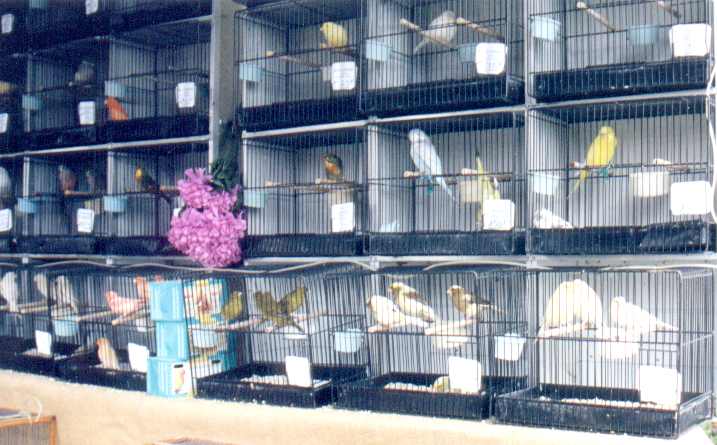
Another gray, wet day, not quite as cold as yesterday. We checked out the sidewalk market at Quai de la Mégisserie, discovered they sell birds! Who would have thought!

Walked past the old Tour St Jacques (map), then up Rue St Denis and through the street level of Forum Les Halles – a pedestrian district deserted on Sunday morning – to Rue de Turbigo, where there's an interesting mural. |
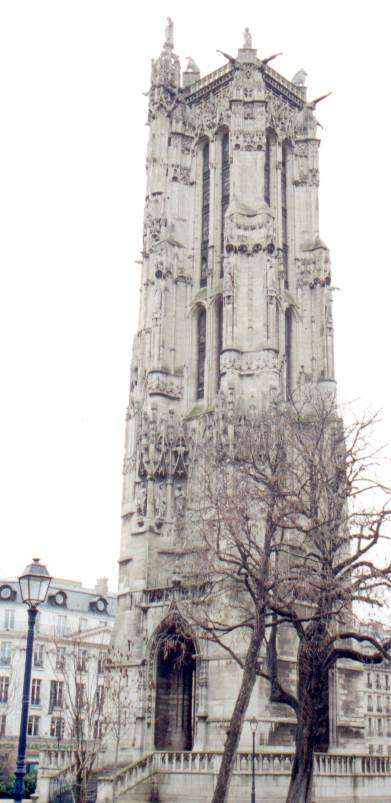 |
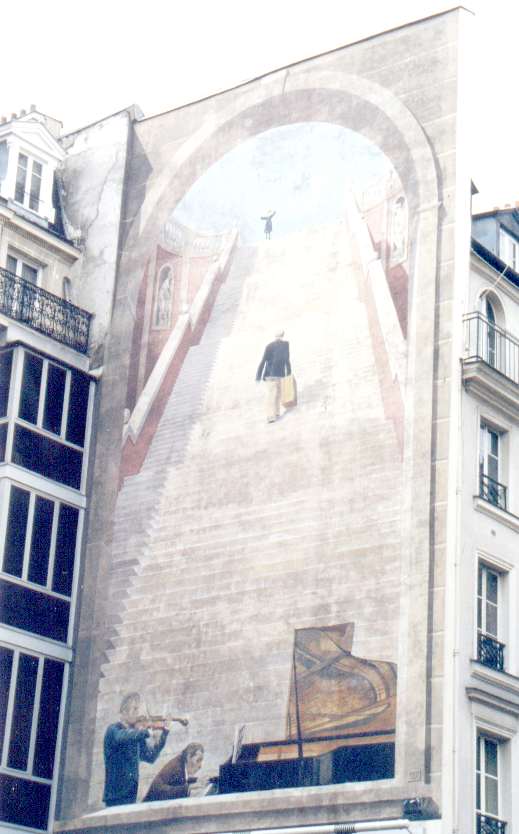
Thence to the Temple, or at least to the marker showing where the Temple once stood and the outline of the quarter. We polish our haloes at the signs, but whatever limited French we once knew is fading fast, and we don’t understand very much. Last time I was in France, I was pleasantly surprised at how much I understood. This time, we understand words here and there, but it’s hard to pick up whole sentences. We’re losing whatever French we once had. Sad.
Nothing left of the Temple now, not even anything obvious at the Square. However, there is a large covered market, the Carreau du Temple, once the Temple tower, a prison. The market was open, occupied by clothing vendors, many of them selling leather clothes. Since we were about the only non-vendors in the place, we got a lot of friendly attention. Any number of people would have been happy to take our money. Sorry, friends, we’re too cheap!
Then we were off to Montmartre (map), where we climbed the steps to Sacre Coeur. There were two or three people around the area acting as statues. The statue of Liberty would have been more impressive but that the upheld arm was artificial. How much stamina does that take, I ask you?
Around in the Place du Tertre was an art fair, both bespoke sketches and finished works, mostly of the Montmartre area itself.
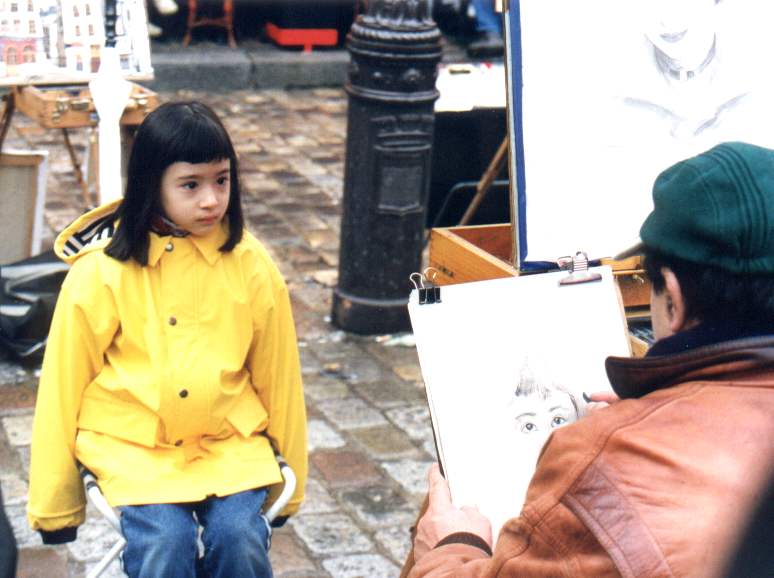
On the way down the hill, we saw the former Cabaret des Assassins, now the Lapin Agile. The name is a pun, the sign having been painted by André Gill (à Gill).
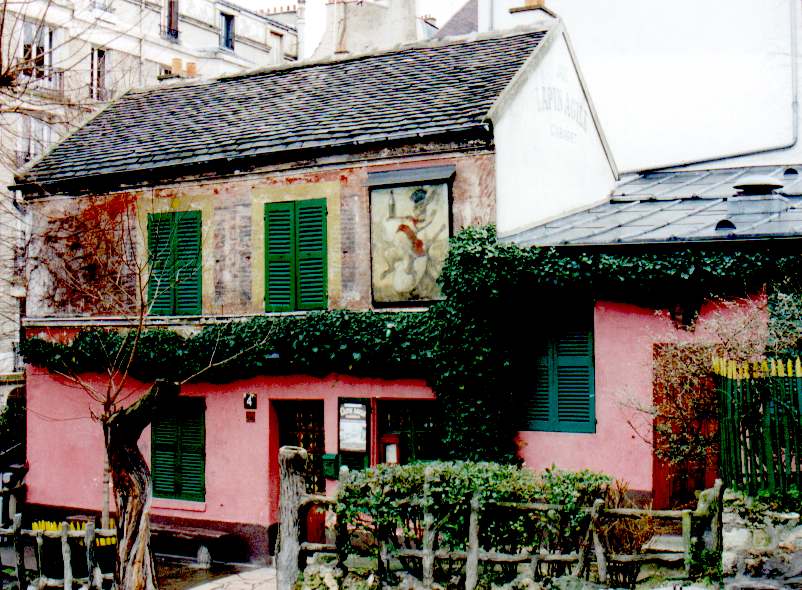
|
It isn't morbid to visit cemeteries; it's our version of historical and art appreciation. We crossed the bridge over Montmartre cemetery and went down into the cemetery itself. I was thinking they must have taken great care not to have disturbed the pre-existing monuments, when Jacky pointed out a good example. |
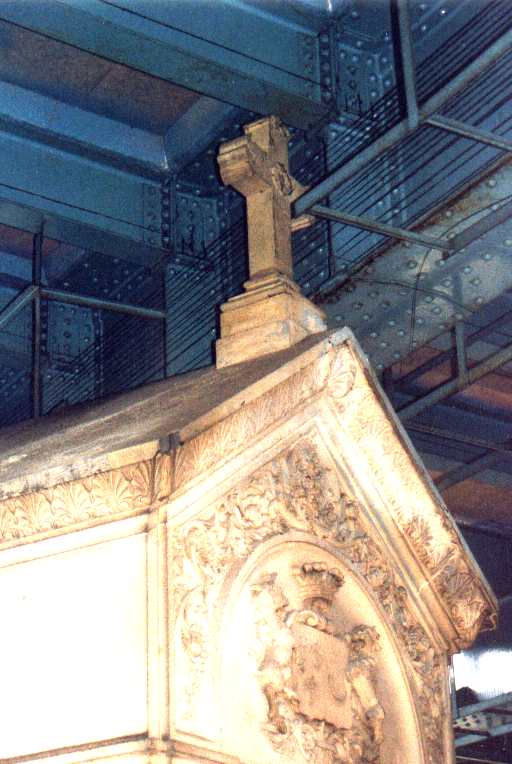 |
There were a number of monuments to people who had been deported and never come back. In most cases, there was no date of death; in some cases, even the year of death was unknown.
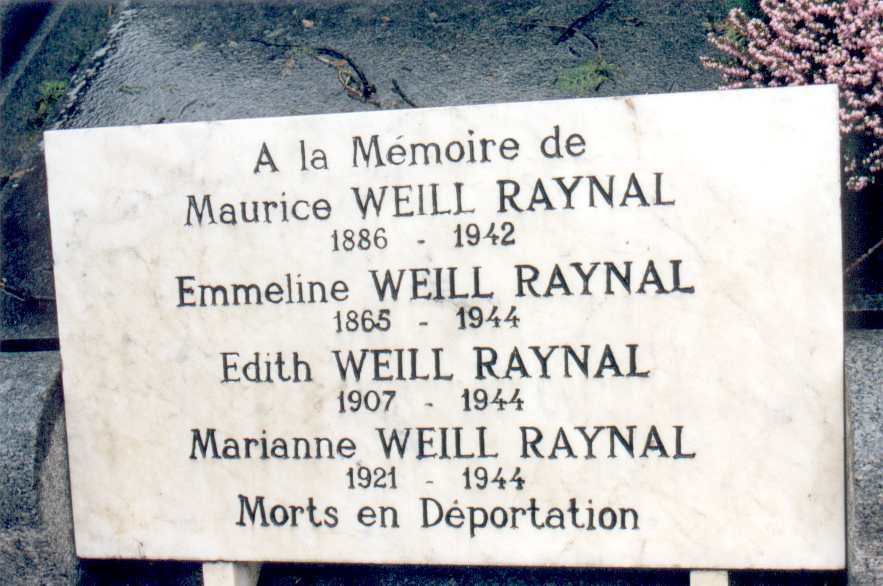
The cemeteries of Paris were badly damaged by ice storms earlier this winter. There are fresh-cut tree stumps, broken-up gravestones in great heaps, and whole sections cordoned off with yellow tape. One bronze bust had the side of its head smashed in.
We found Hector Berlioz’ grave, and Foucault’s, he of pendulum fame.
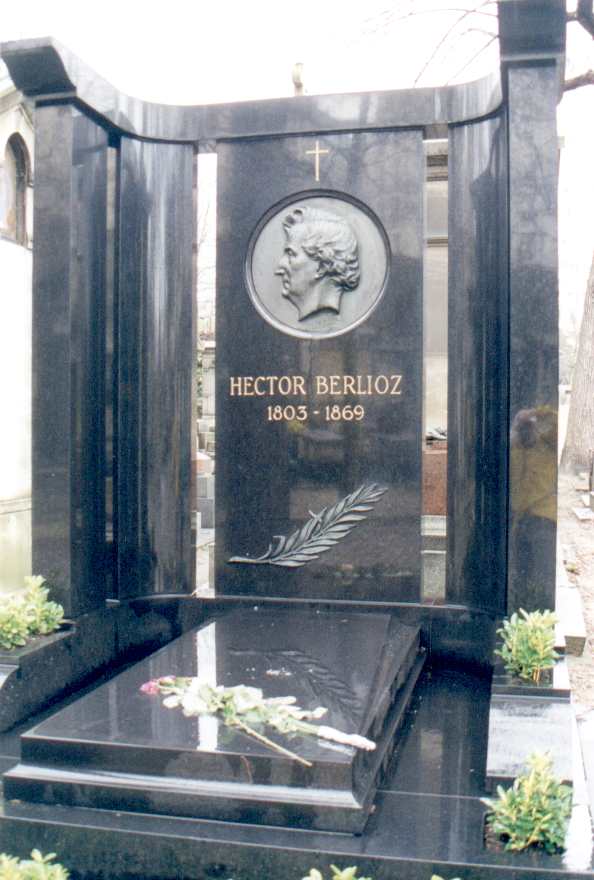 |
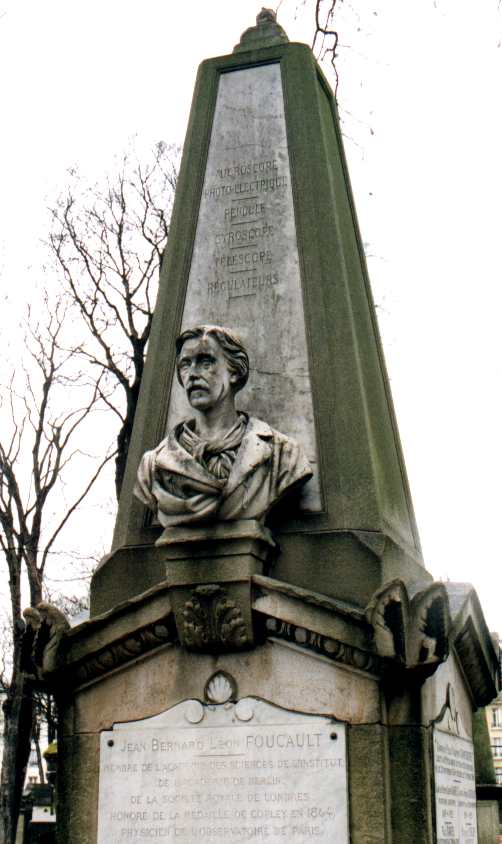 |
We missed Offenbach and Heinrich Heine, who are also here. And one of our favourite Frenchmen, Gabriel Fauré; – where is he? I don’t recall ever coming across him, anywhere. It’s a mystery.
Wandered back past the Moulin Rouge and toward center city. Light rain, cold.
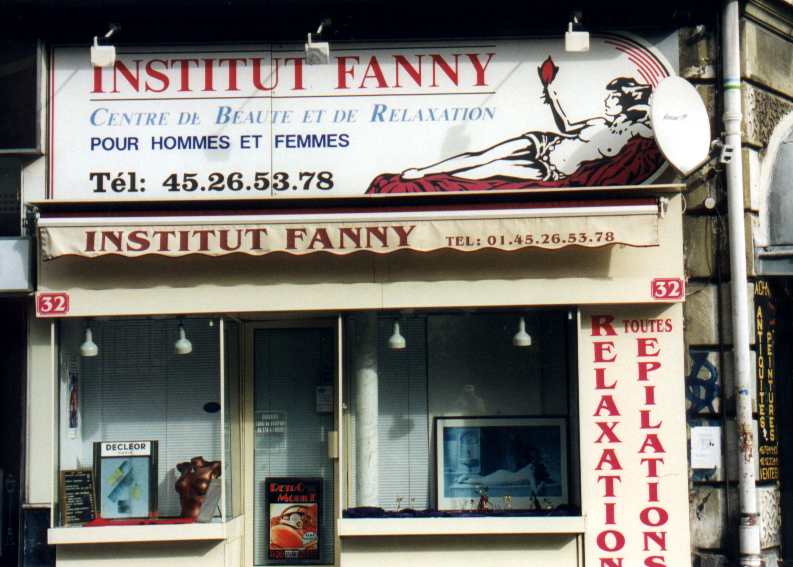
I learned that one of Haussmann’s purposes in building these amazingly wide boulevards through Paris was to prevent street barricades. A counter-revolutionary! I also wonder about the victims of his city planning. Today we see only the result, but it’s hard to think that the city could have been so completely rebuilt without the heavy hand of government dispossessing thousands of people, confiscating and destroying their property. It might be interesting to research the history. Maybe Haussmann had a personal reason to prevent the building of barricades! (I got the book and wrote a review after reading it.)
Bought some clementinen, found a dry shelter in a little park to sit and eat them. It never did rain hard, but it was a damp, drizzly day.
Then we went to see two of the remaining city gates, the Portes St Denis and St Martin (map). Though they date from the 17th century, they’re in very good condition, perhaps having been restored many times over the years.
Toward the Centre Pompidou, a large, modernistic, all-purpose cultural center. On the way, we discovered the Defender of Time. Every hour, he must defend against the dragon (earth), the crow (air) or the crab (water), and three times a day, all three attack together. Since it was only the half hour, we didn’t wait around to see the performance. |
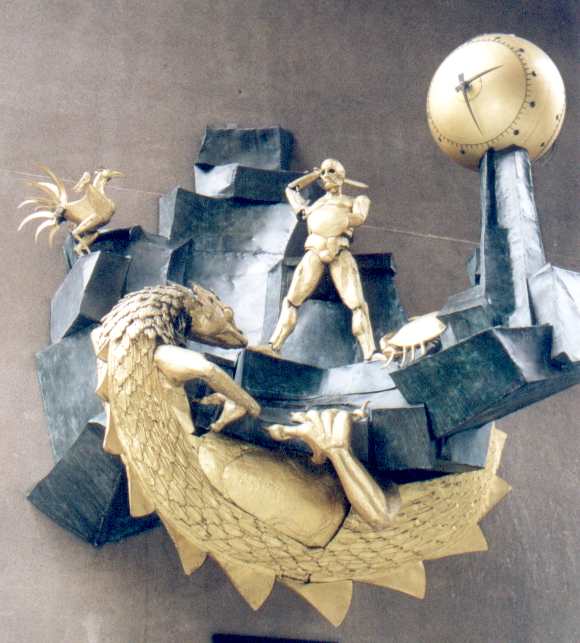 |
I always congratulate myself when I understand a pun in a foreign language. It turns out there are at least two bookstores with this name, and likely more.
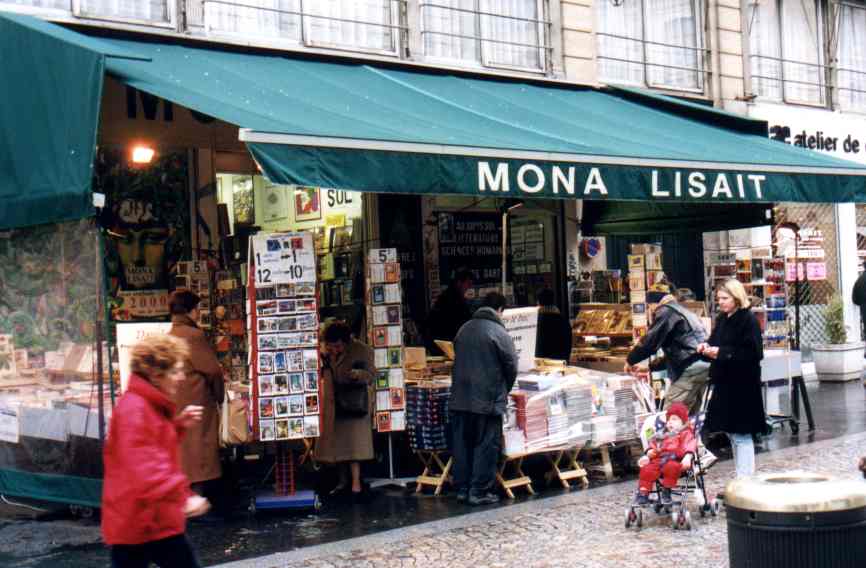
We looked in at St Julien le Pauvre, where a Chopin performance was due to begin in half an hour, but at FF150, we’re not diehard Chopin fans.
We were walking up Boul Mich toward the hotel, when I noticed someone walking very close behind Jacky. The zipper on her shoulder bag was open three or four inches, and the guy had his hand inside. Kid maybe fourteen. I faced him down, gave him a blast of Anglo-Saxon whose meaning was undoubtedly clear even if he didn’t understand the words, and he turned and walked back down the boulevard. It’s too bad the downside of his attempt was so minimal – this is a kid well down the path in a very wrong direction.
Stopped at the hotel to warm up, rest the feet, trim the toenails. Then out to explore another new neighborhood. Just east on Rue Cujas is the Panthéon, which we skipped, and St Étienne du Mont, an old church with Pascal and Racine among its entombed celebrities. The front has been restored, but the windows are still pretty dark.
I have a theory that we’re like ants. We have a more-or-less well-defined path that we normally take, but there’s always a little randomness, for curiosity or boredom, inattentiveness or just plain error, and eventually, we end up discovering just about everything. And so it was tonight.
We had not previously known about Rue Mouffetard, another mostly pedestrian street leading toward Montparnasse (map). Interesting restaurants, but not open yet. Our distaste for smoke limits our willingness to spend time in bars or coffee houses while we wait.
Walked down and back, found a fondue place with food à toute heure. The beer was called 1664, not bad. We had hot chèvre salad and beef fondue. Pretty, pretty spoiled!
Happy Valentine’s day! It’s not just a US holiday: the stores here also have displays and would like to take your money. We got up an hour earlier today; Jacky has an all-day meeting out toward La Defense, near Les Sablons Métro.
I went walking, left her to her own devices. Went past the University (Pierre and Marie Curie Institute), across Pont d’Austerlitz, and through a very ordinary neighborhood (map): Avenue Ledru-Rollin and Rue de la Roquette to Père Lachaise cemetery. There were lots of workmen around, repairing damage from the ice storm.
Imry-Nagy is here, or was, with a quite unusual monument. He was the minister-president of revolutionary Hungary in 1956, executed by the Soviets when they suppressed the revolution.
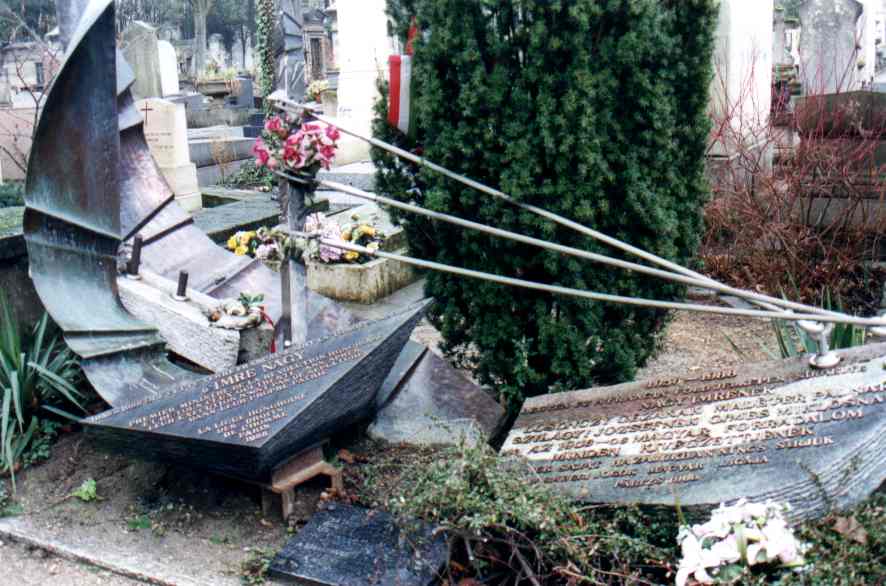
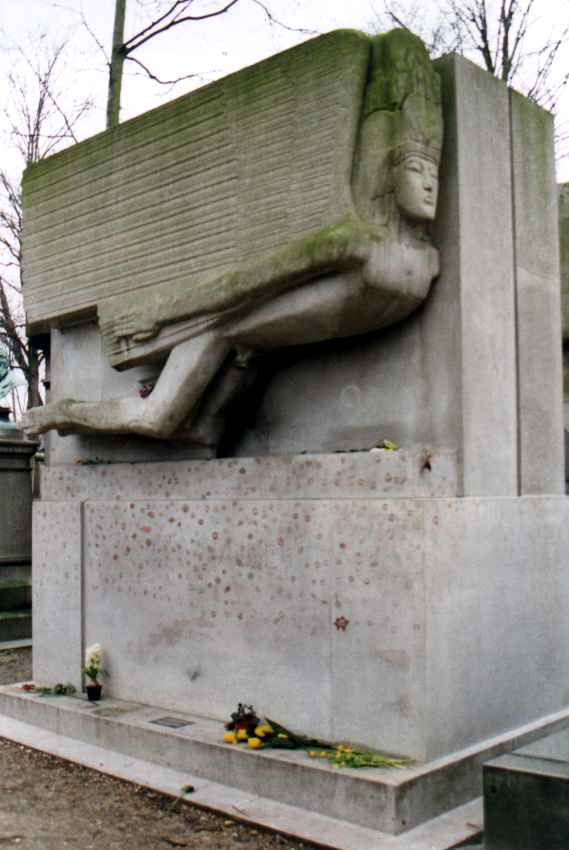 |
Oscar Wilde’s monument attracts kisses – that’s what the colored marks are. A sign at the base, in English and French, asks the public to respect Wilde’s memory, not to deface the monument. |
And appropriately enough for Valentine’s day, the grave of Héloise and Abélard. |
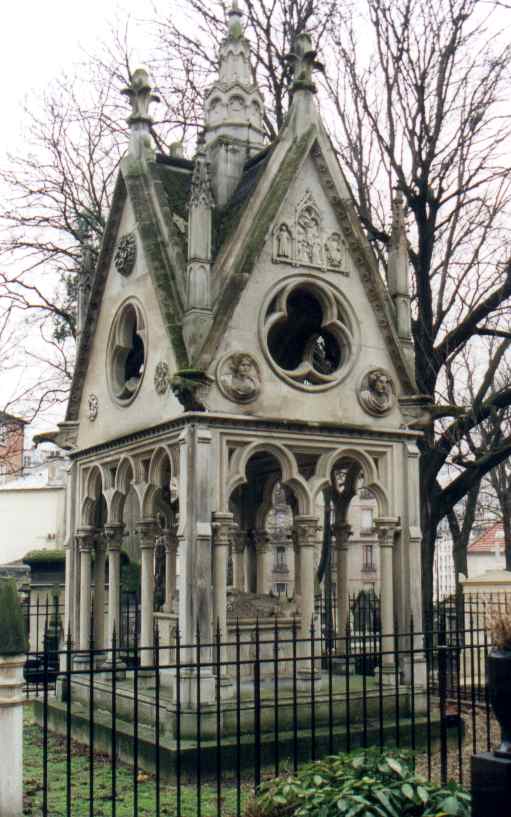 |
But no Gabriel Fauré. Where could he be? Is it conceivable that he’s not even here in Paris?
Walked out along Boulevards Ménilmontant, de Belleville, de la Villette (map), through something of a Chinatown. The boulevard is very wide, with an island that is sometimes a parking area, sometimes open. Two or three of the open stretches were being set up as street markets, crews busy installing tubular scaffold frames over which awnings could be spread. Didn’t see any indication of the merchandise to be offered.
|
Speaking of scaffolds, there was a sign and a sketch of Montfaucon gibbet, so efficient that sixty people could be executed simultaneously. It had four planes, each something like the sketch. Nothing like the efficiencies of mass production! |
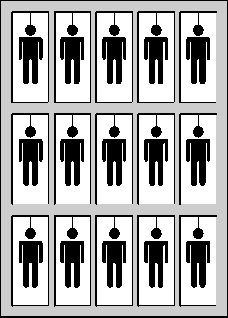 |
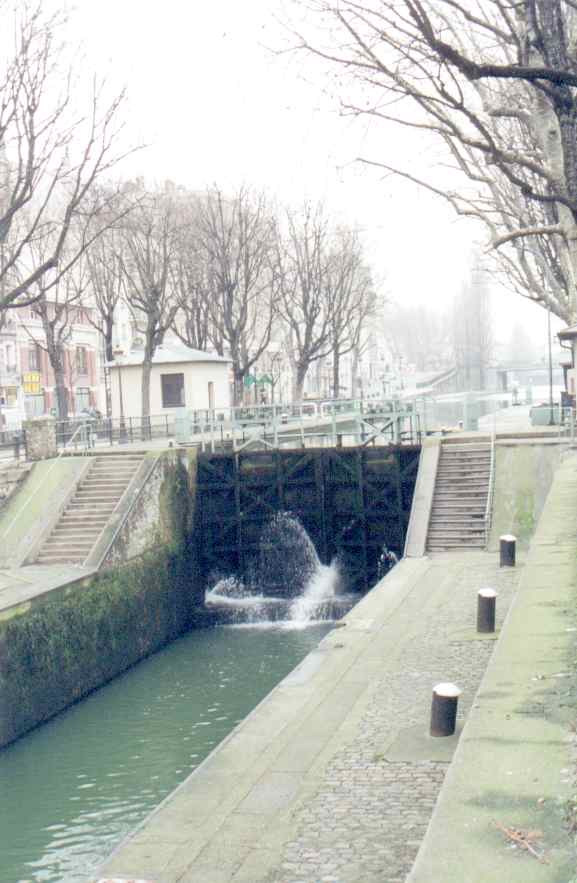 |
The picture I had seen of the Canal St Martin made it look as if it ran through a wood. There was a wooded playground strip along the canal, but it was pretty tightly bracketed between urban streets. |
|
A nearby building has an aquatic mural. I suppose they use the canal for rowing. You certainly couldn’t do that on the Seine. |
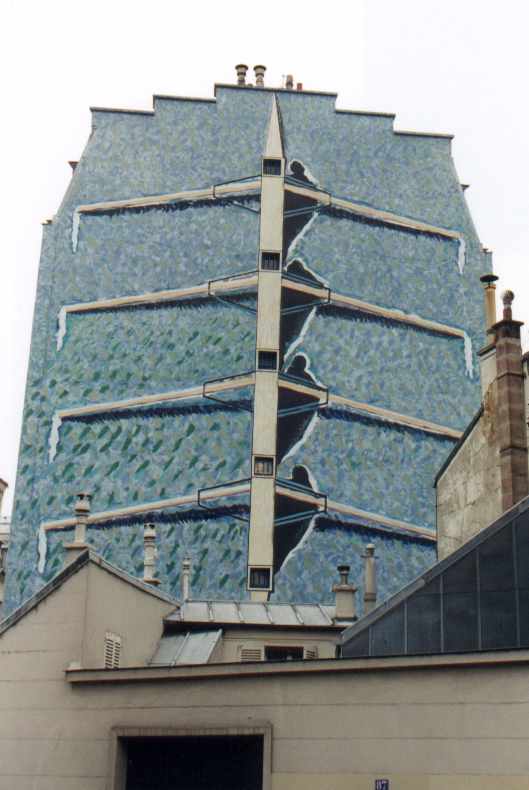 |
Down Rue de Lancry to Boulevard St Martin, over to Porte St Denis and down into the town. It’s a strange combination of garment district and red-light district. In fact, the first few Professional Women I saw were wearing fur coats – I thought they might be modeling for the firms in whose doors they stood. We were here yesterday and saw nothing of this. Never on a Sunday – it’s really true.
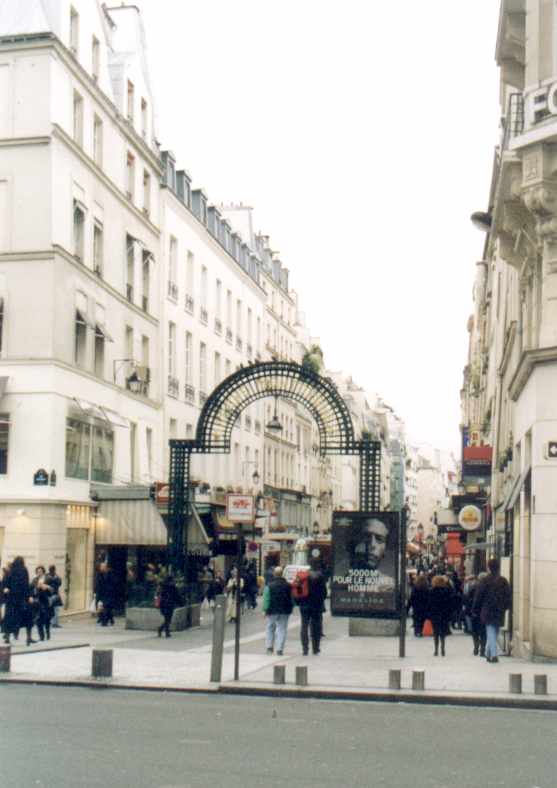 |
By the time you reach the Montorgueil-St Denis quarter, which begins at Rue Réaumur, the hookers thin out. It’s still very much a garment district, though. The Passage du Caire, just north of Rue du Caire, is a hallway going past businesses in the clothing trade. It leads to the old court of miracles, described in The Hunchback of Notre Dame, where the crippled beggars miraculously shed their deformities of an evening. Today it’s a small triangular square, the entrance to the Passage embroidered with an Egyptian theme. The halo-polishing sign describes the Egyptian façade, but not the Cour des Miracles. Quartier Montorgueil-St Denis (map) is another nice, busy pedestrian neighborhood that I hadn’t previously known. It’s even paved with white tiles, a clear indication to the occasional cars that they’re out of their natural element and ought to be on their best behaviour. The side streets are disappointingly empty, but Rues Montorgueil and St Denis are busy. |
|
Most of the history signs of Paris – as best I can decipher – are full of generals, politicians and priests, death, destruction and misery. The signs in this neighborhood describe the coffee-houses, and the poets and artists who frequented them. Much better! | 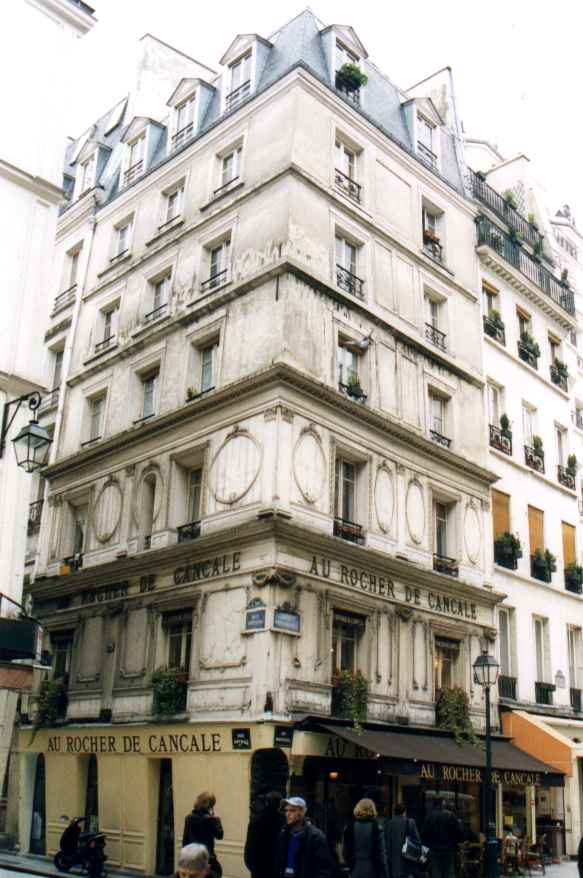 |
Getting hungry. I gave Jacky all my coins for the Métro; all I had was a FF200 note. I could imagine getting yelled at, trying to buy 10 or 20 francs worth of lunch. I wasn’t interested in McDonald’s, nor willing to go hungry. So I went up to a sidewalk sandwich stand and started off by explaining that all I had was a 200-franc note, and I hoped they would be able to exchange it. Pas de problème! One sandwich, coming up! A mini-baguette, split, with lettuce, ham and soft cheese slices. Went to the lower level courtyard of the Forum to eat it.
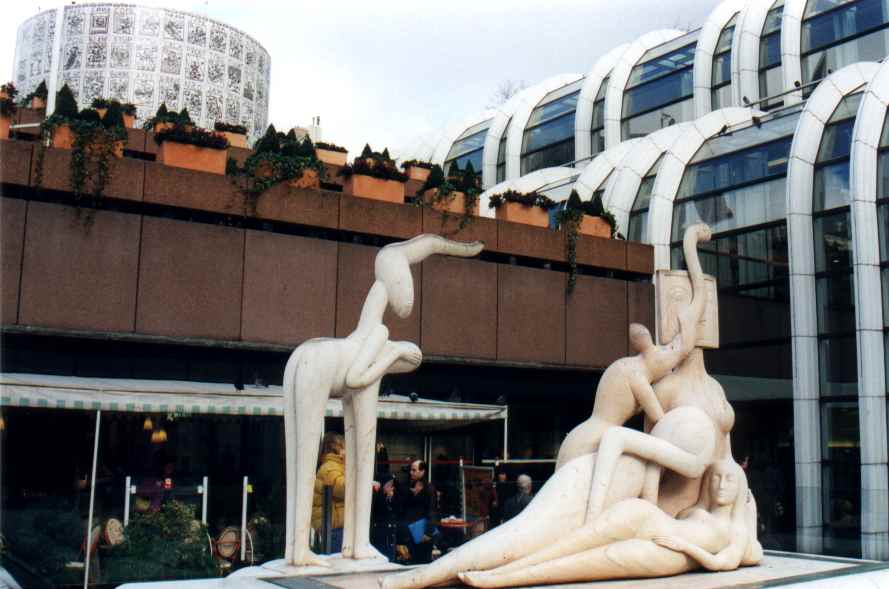
Then spent a minute in St Eustache, a dull church not improved by the presence of a loud drunk.
Headed back toward the hotel, through the Louvre. Amongst the generals, politicians and priests, I thought Mansart was worth a photo, a private contributor to the betterment of the world. He did not actually invent the mansard roof, but his name got attached to it. Interesting that the building at his feet does not have a mansard roof – he was a general purpose architect, not just a roof-builder. |
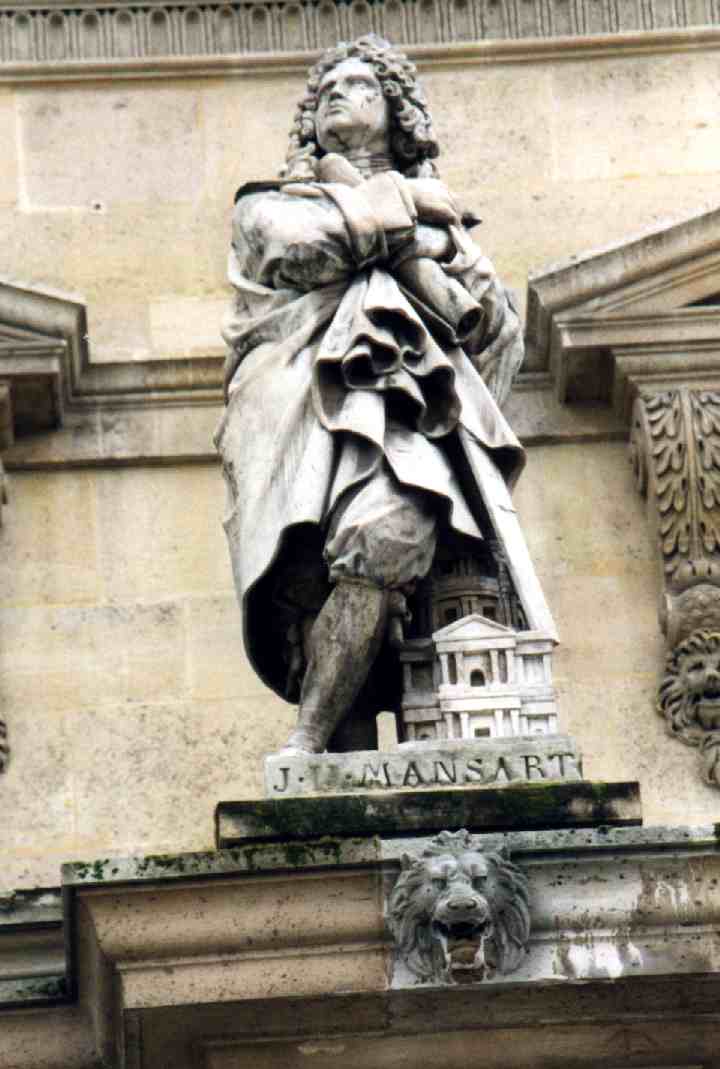 |
Sat on a bench in the Louvre courtyard for a few minutes, but the wind came up and it was chilly enough to move me along. Came across Pont Royal and along Rues de l’Université and Jacob – not very interesting.
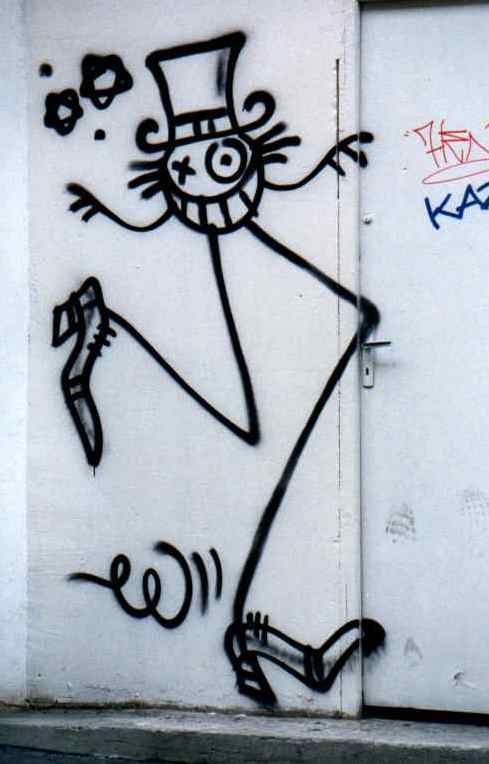
Turned up Rue Monsieur le Prince, where there’s a graffitus whose unique style caught my eye. We saw more of this guy’s work here and there around the city, too. I don’t approve of graffiti, but it’s at least nice to see a certain originality.
Back to the hotel to rest the eyes and feet. It started raining fairly hard, so I didn’t go out again. Jacky arrived about 6:15; the rain had stopped, and we went out. Wandered down into the rabbit warren, where the barker for La Taverne de la Huchette got us in his door. Not much smoke, and the food was fine. Salmon for me, a chicken-mushroom crêpe for Jacky.
The seating was along long tables, with, since they weren’t full, an empty seat between each group. As they got up to leave, the couple one down from us said, “Give our best to the United States.”
The waiter had a hand-held terminal for the credit card. He swiped it, unsuccessfully, swiped it again, polished it against his shirt, spit on it, swiped it, no luck. The other waiter came over, swiped it once, it worked fine. It’s all in your technique.
A very congenial evening.
View Guestbook
Jacky’s home
Dave’s home
View old guestbook
Email: ![]()